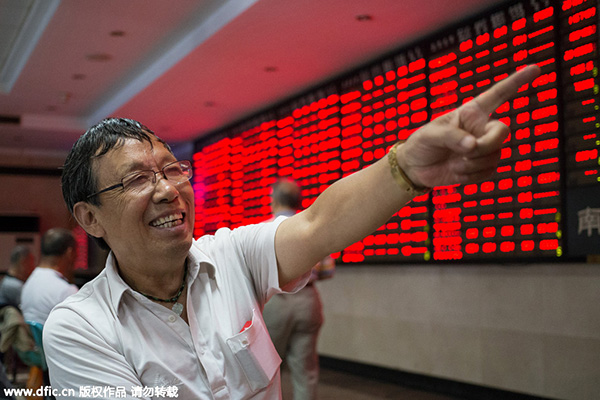Trapped in carnival of horrors
|
 |
|
Chinese investor smiles as he looks at prices of shares (red for price rising) at a stock brokerage house in Nanjing city, East China's Jiangsu province, July 10, 2015. [Photo/IC] |
Investors, regulators and the media have all played their part in the great market panic small investors have been badly hit by the turmoil that has engulfed the Shanghai and Shenzhen markets. Around $3.5 trillion in value has been wiped off in the space of three weeks.
But before the markets started to tumble, investors were riding a wave of euphoria on the back of an amazing bull run. So what went wrong? How did confidence in the markets drain away?
Below are excerpts from articles written by two leading Chinese market watchers, Hu Shuli and Wu Xiaobo. They look at what has happened-and how small investors can use the lessons of the past to help them in the future:
Hu Shuli, editor-in-chief of Caixin Media, a company specializing in financial and business information
No one can predict the future trend of the stock market, but the recent plunge has thrown up lessons that investors and regulators need to take in.
The first lesson is about the risk of ignoring market laws. There was a "conspiracy theory" about foreign speculators coordinating with "domestic traitors" to short sell the markets.
But people who hold such views ignored the fact that a liquidity-fueled rally without the support of economic fundamentals is very dangerous as it accumulates significant risks. This makes it vulnerable to a massive sell-off.
One of the new characteristics of the old bull run was leveraged trading. Margin loans reached 4 trillion yuan ($650 billion) when the market peaked. This in turn magnified the risk and increased volatility.
The second lesson is that there is a lack of effective collaboration and coordination when it comes to regulation. It would be unfair to say the regulator was unaware of the risks associated with leveraged trading. But financial innovation and the introduction of new trading tools have created regulatory "blind spots".
Investment was not only flowing into the markets through brokerage channels. Leveraged funds also came from wealth management products and trust companies, as well as the rising online peer-to-peer fundraising platforms, which need tighter regulation.
Effective regulation, with better coordination among various government agencies, is needed. The regulator should broaden the legal channels for capital investment from the banking sector to flow into the stock market. In the meantime, the regulator should increase its efficiency in monitoring the market, which will help reduce financial risks.
The third lesson is that policy goals should not be propping up the markets. Quite simply, a policy-driven market is risky. The regulator should concentrate on improving market mechanism, which will establish long-term investor confidence.
If instead the regulators start to panic during a short-term period of market volatility and respond through administrative intervention, it will do nothing to restore confidence. In fact, it could cause lasting damage to the regulatory system.
















